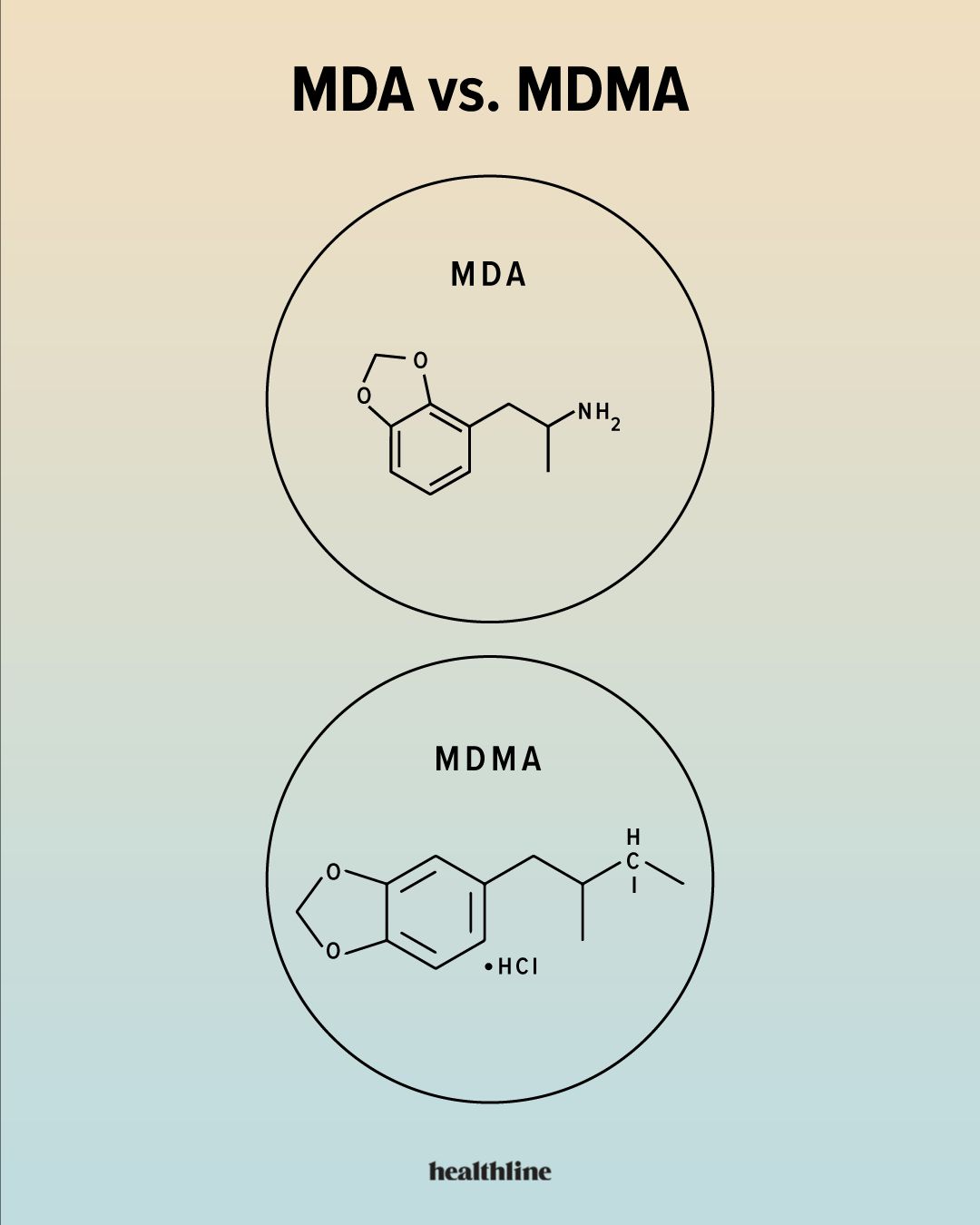MDA and MDMA are related substances within the amphetamine class, sharing a similar chemical foundation but with distinct effects.
Also known by their street names “Molly” and “Sally,” MDMA and MDA are popular party drugs.
While they share a chemical foundation, their effects can be slightly different. One induces more euphoria and emotional openness, while the other induces greater hallucinogenic and stimulant effects.
MDA (3,4-Methylenedioxyamphetamine) and MDMA (3,4-Methylenedioxymethamphetamine) are synthetic, psychoactive substances belonging to the amphetamine and phenethylamine classes of drugs.
Structurally, MDA and MDMA are related compounds with a shared chemical backbone. In fact, MDMA is derived from MDA through a chemical modification process.
When you take MDMA, your body breaks it down into MDA through a process called demethylation, mostly in the liver. MDA is an active byproduct of MDMA and contributes to the overall effects of MDMA.
Both MDA and MDMA have stimulant and hallucinogenic effects, though their intensity and duration can vary.
MDMA
MDMA is a well-known recreational drug commonly referred to as “ecstasy” or “Molly.” It produces intense feelings of euphoria, emotional openness, and empathy. It also enhances sensory perception and acts as a stimulant, increasing energy levels.
Research shows that MDMA stimulates the release and inhibits the reuptake of the neurotransmitters serotonin, dopamine, and norepinephrine. Among these, MDMA exerts its most potent effects on serotonin.
The excessive release of serotonin caused by MDMA use can lead to a notable reduction of this neurotransmitter in the brain. As a consequence, people may experience negative psychological aftereffects such as depression, anxiety, and fatigue, which can persist for several days following MDMA use.
MDMA also consistently leads to adrenergic effects, such as increased heart rate and blood pressure, primarily attributed to the release of norepinephrine.
MDA
MDA, also called “Sally” or “Sassafras,” produces euphoria, increased energy levels, enhanced sensory perception and empathy, and altered time perception.
MDA tends to produce stronger visual and auditory hallucinations compared to MDMA, as MDMA is typically more associated with a more pronounced empathogenic and euphoric experience.
MDA is also considered to have more stimulant properties and can provide a greater boost in energy levels compared to MDMA. It also typically takes
Similar to MDMA, MDA’s action on serotonin receptors can lead to negative psychological aftereffects such as depression, anxiety, and fatigue that may be experienced for several days following use.
Is MDA or MDMA more dangerous?
MDA and MDMA are both classified as stimulant drugs and can increase the release of serotonin, dopamine, and norepinephrine in the brain.
Both drugs carry potential risks and have adverse health effects. The specific danger of each substance depends on factors such as dosage, purity, individual variability, and the context of use.
The individual experiences of each drug can vary, and their effects can depend on factors such as dose, purity, individual physiology, and setting.
| Effects | MDA (methylenedioxyamphetamine) | MDMA (methylenedioxymethamphetamine) |
|---|---|---|
| Euphoria | Yes | Yes |
| Increased energy | Yes | Yes |
| Enhanced sensory perception | Yes | Yes |
| Empathy | Yes | Yes |
| Altered time perception | Yes | Yes |
| Visual hallucinations | Stronger compared to MDMA | Possible, but typically less pronounced compared to MDA |
| Auditory hallucinations | Stronger compared to MDMA | Possible, but typically less pronounced compared to MDA |
| Stimulant properties | Stronger, provides a greater boost in energy levels | Less pronounced, but still present |
| Overall experience | More hallucinogenic and stimulant effects | More empathogenic and euphoric effects |
| Duration | Typically takes 10–12 hours to be fully removed from the body | Typically takes 7–8 hours to be removed from the body |
Both MDA and MDMA are controlled substances in many countries due to their potential for abuse and adverse health effects.
The signs of an MDMA/MDA overdose can vary because it’s possible that it may overlap with serotonin syndrome. But here are some potential indicators:
- dangerously high body temperature (hyperthermia)
- cardiovascular effects, such as elevated blood pressure, rapid or irregular heart rate, cardiac arrest
- dehydration
- confusion and disorientation
- uncontrolled tremors or seizures
- unconsciousness or loss of consciousness
An overdose of MDA or MDMA can have potentially life threatening consequences. If you suspect someone is experiencing an overdose, it’s crucial to seek immediate medical help by calling emergency services.
Always be honest with emergency personnel. The information you give them is confidential and could save the life of someone overdosing.
Emergency services may give activated charcoal to someone who is overdosing. If you regularly use MDMA or MDA, it can be useful to keep activated charcoal on hand, but always ask the 911 operator before taking it or giving it to someone.
While MDMA is classified as a Schedule I substance in the United States — which implies it has a high potential for abuse and no accepted medical use — there has been a recent shift in the understanding of its therapeutic benefits.
Studies show how the drug can reduce anxiety and lead to profound states of introspection and personal reflection.
Because of this,
If you want to learn more about possible therapeutic uses for MDMA, you can go to ClinicalTrials.gov to see what clinical trials are looking for participants. Make sure to always discuss clinical trials with your primary doctor, psychiatrist, or therapist before starting.
MDMA and MDA are similar psychoactive substances with overlapping but distinct effects. MDA is known for its stronger hallucinogenic properties and stimulant effects, while MDMA is recognized for its empathogenic and euphoric experiences.
Both substances can have significant impacts on neurotransmitter systems, particularly serotonin, and prolonged or heavy use may increase the risk of adverse effects.
Research and understanding surrounding MDA and MDMA continue to evolve. Ongoing scientific studies aim to explore their therapeutic potential, safety profiles, and potential risks.

